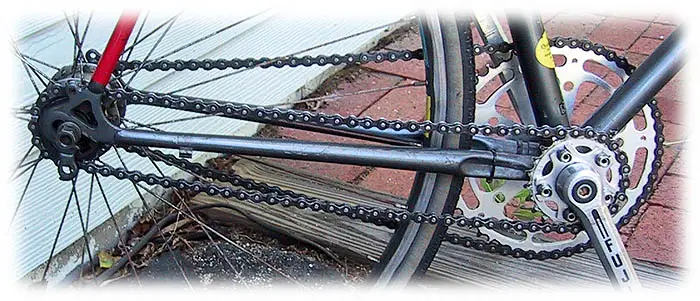
|
Sheldon Brown

![]()
![]()
The bearing race inside the ball cup also will have been softened. Tack welding the planet cage to the ball cup, or making a connection with a steel bar, as described in another article, would avoid this problem, but cutting threads would be more difficult. -- John Allen
A better, but more costly solution would be to use a tandem synch crank on the left side, as I did on my Gunnar 3-speed fixed gear. -SCB
A right crank which is integral with the spider would still need a modified pedal, but still would be better,. A swaged crank which drives in both directions is likely to loosen from the spider. I've had swaged cranks welded to the spider to get past this problem. -- John Allen
Ah -- Different chain slack is an issue with a bichain system I hadn't thought of. -- John Allen
When the neutral position is selected, pedaling forward engages the freewheel gear. The main design constraint is that the (highest) freewheel gear must be lower than the lowest fixed gear, or else the drivetrain will bind up.
![]()
![]()
It is very mesmerizing to watch while spinning on a workstand.
 |
 |
 |
 |
![]()
![]()
Bruce, It's not clear to me how you assemble the hub after brazing the planet cage to the ball cup, nor how you get the planet cage properly aligned with the ball cup prior to brazing? -SCB
Freedom of the planet cage to align itself on the gears increases gear life with the stock hub or the metal bar connection for a fixed gear. -- John Allen
In the last few I've created, the (splined) left cup is removed from the steel shell by placing the flanges on a vise and using a hammer and pipe to bang it out. The left shield and bearing are removed and the cup cleaned so that no grease is left to burn in place; all the components in the planet cage are removed as well. The finish needs to be removed from the the edge of the ratchet (using a Dremel) and the outside of the interior flange of the planet cage (with a grinder) to give clean surfaces for brazing.
To assemble the ball cup and planet cage for brazing, three 1/4" balls are placed in the planet cage pawl recesses at three locations approximately 120° apart. The planet cage is then press-fit using hand pressure into the ratchet track; this centers it well enough for the brazing operation. Grease (or some other "dirty" compound) should be applied to the splines to avoid wicking the braze onto them, which would make fitting the left ball cup back into the shell difficult. The planet cage is then brazed to the ball cup just inside the spline.
After brazing, the left ball cup is pressed back into the hub shell using the vise.
Reassembly is a bit of a jigsaw puzzle. The normal means of assembly won't work, since the planet cage is normally part of the internal assembly. The planet gears are inserted through the left axle hole, then secured in place with the pinion pins. After that, the axle, left bearing and shield are installed, in that order (don't let the pinions fall out!) The remainder of the internals can then be built normally inside the hub, save for screwing the right ball cup into the hub shell before installing the driver and excluding the ring gear pawls, pins and springs.
The "right hand ball cup" (now on the left side) needs to be secured with Loctite or similar thread-locking adhesive, or it will loosen up
I've built three or four this way and although they can be a bit noisy, the friction has never been excessive.
I normally grind out the normal-position dogs on the gear ring to give a neutral (freewheeling in both directions) position between the decrease and normal gear. If this is done, it's vital to use a shifter which can't easily be bumped out of position (as trigger shifters are designed to be): an unexpected shift out of the neutral gear when coasting could easily result in a crash!
Coasting in the neutral gear can also be a bit unnerving, since in this setup the planetary gears are always rotating and making noise regardless of the shifter position, and they're more noisy from lash when unloaded.
By the way, it appears the brake thread on the current SRB3, AWB or RS-RB3 may make them better candidates for use with a bichain setup, although I'm not sure how easily the rotary changer models would convert to 2-speed fixed.
![]()
![]()
Last Updated: by John Allen